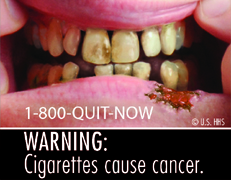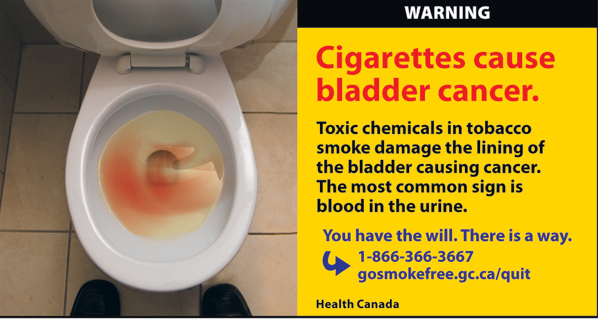Center for Communications, Health and the Environment

New Graphic Warnings Could Have
Great Impact - IF Enacted
In what a June 2011 USA Today labeled “the most sweeping anti-tobacco effort since the surgeon general's warning became mandatory on cigarette packaging in 1965,” the United States may require graphic health warnings to appear prominently on every cigarette pack and cigarette advertisement across the nation.
Developed as part of the Family Smoking Prevention and Tobacco Control Act, a national strategy to eliminate tobacco-related death and disease, the new cigarette warnings include nine hard-hitting images of corpses, cancer-ridden lungs and rotting gums designed to prevent children from lighting up, encourage adult users to quit and enhance awareness of the dangers of smoking. The Food and Drug Administration (FDA), which is responsible for the pictorial labels, states that the images were selected based on “their ability to effectively communicate the health risks of smoking,” and after reviewing relevant scientific literature, more than 1,700 public comments and results from an 18,000 person study.
 |
 |
The United States is poised to place these, and seven other, graphic health warning labels on cigarette
packs and ads nationwide. |
|
The new graphic health warnings are supposed to go into effect in September 2012. At that time, all cigarettes for sale or distribution in America are to be manufactured or advertised with the warnings covering the top 50 percent of both the front and back panels of each cigarette package and at least 20 percent of the area of each cigarette advertisement. The proposed timeline faces indefinite delays, however, due to legal action by a number of cigarette companies; and now it is unclear when – or even if – the new warning labels will debut.
Persuasive Pix
If enacted, the new U.S. warning labels will resort to revulsion and shock value to deliver a preventive punch. They depict everything from close-ups of rotting teeth and gums, and healthy and diseased lungs to a spiritless sharply dressed man wearing an oxygen mask, to a baby in its mother’s arms suspiciously eyeing a cloud of second-hand smoke accompanied by text like, “Cigarettes cause cancer...cause lung disease...cause strokes and heart disease” and “Tobacco smoke can harm your children.” They are gruesome, explicit, and designed to dissuade.
Statistics Show...
According to the World Health Organization (WHO), 10 million cigarettes are sold worldwide every minute, more than 2,000 children under the age of 18 start smoking every day, and more than 3 million U.S. adolescents, and about one in five adults, are cigarette smokers.
Despite tax increases, $5-a-pack price tags and laws restricting or banning smoking in more than 30 states and 3,000 municipalities, U.S. cigarette consumption has not declined since 2003. It hovers around 21 percent of the population, a steep drop from its 42 percent apex in the mid-1960s, but still high enough to put tens of millions of Americans at risk and precipitate 443,000 tobacco-related deaths a year.
 |
(Source: WHO Report on the Global Tobacco Epidemic, 2011) |
Substantial international research and data collected through WHO indicate that health warnings like the ones proposed in the United States encourage tobacco users to quit and help keep young people from starting; and knowledge about the dangers of tobacco use is higher in countries with package health warnings, according to the WHO Report on the Global Tobacco Epidemic, 2011 (see chart above). A recent international study from the Centers for Disease Control and Prevention found that about 25 percent to more than 50 percent of smokers say graphic health warnings make them more likely to quit, and chart data in the 2011 WHO Report echoed this finding, with the Canadian Journal of Public Health, 2004, reporting that about three in 10 former smokers said that graphic labels had motivated them to quit and more than 25 percent said that labels helped them continue to abstain.
 |
(Source: WHO Report on the Global Tobacco Epidemic, 2011) |
Australia introduced graphic health warning labels in 2006 that caused more than half of smokers to believe that they had an increased risk of dying from smoking-related illness, with 38 percent feeling motivated to quit, according to a research article in the European Journal of Public Health, 2009. Other countries with pictorial warning labels, including Brazil, Singapore and Thailand, have reported similar effects on smoking-related behavior, according to the WHO Report on the Global Tobacco Epidemic, 2011.
But intentions don’t always translate into actions, and some health specialists say graphic health warnings may only temporarily deter, with smokers becoming desensitized over time. Other experts have noted that the heavy-hitting images on Canada's cigarette packages may have not lowered that nation's smoking rates.
Nevertheless, the U.S. government is hoping such graphic warnings will help cut the percentage of smokers in the United States to 12 percent by 2020, while greatly reducing the number of tobacco-related deaths.
 |
This is one of 16 explicit new health warnings that will appear in Canada in June. (Source: Health Canada) |
About 40 countries already require graphic labels, including Canada, which was the first country to introduce them on cigarette packages in 2001 and will issue a new round of 16 to cover 75 percent of the front and back of cigarette and little-cigar packaging in June 2012. Mexico also mandates such labels, as does Mauritius, the first and only African country to require them, and Uruguay, which currently has the world’s largest pictorial health warning requirements for cigarette packages at 80 percent (as an average of the package front and back).
In general, warning labels are overwhelmingly supported by the public, often at levels of 85 percent or higher, and even most smokers support labeling requirements, according to the WHO Report on the Global Tobacco Epidemic, 2011.
Obstacles to Enactment
Cigarette manufacturers, on the other hand, tend to vehemently oppose aggressive labeling requirements. Consequently, America’s new large graphic health warnings may never see the light of day – or the face of a cigarette package or advertisement: On November 7, 2011, a federal judge blocked the new FDA labeling requirement, saying that forcing tobacco companies to place such obvious anti-smoking health warnings on cigarette packaging violated their 1st Amendment rights.
 |
| U.S. cigarette makers, along with a federal judge, say that the new graphic health warnings, including the one above, are openly anti-smoking and therefore violate the companies' 1st Amendment rights. |
The injunction came after a series of challenges in court precipitated by a lawsuit by a group of cigarette companies led by R.J. Reynolds Tobacco Co. and Lorillard Tobacco Co., which increasingly rely on their packaging to build brand loyalty and attract consumers, especially since magazine, billboard and television advertising is off limits.
Appeals are underway, and the ongoing legal struggle could delay the new warning labels for years – or perhaps forever. This is favorable news for the plaintiffs, who will likely save millions of dollars in lost cigarette sales and increased packaging costs.
It is unfortunate news for the nation, however, which will lose thousands upon thousands of lives that might otherwise have been saved. But the combined tenacity of health ministries and tobacco-control advocates can turn the tables for positive results. Such partnerships and determination made a difference in Canada and Australia, as well as in Djibouti, where, within the first year of implementation in 2009, sales of tobacco products with explicit images were substantially lower than those with vague ones, and in Uruguay, where results from the Global Adult Tobacco survey revealed that nearly half of that country’s smokers are considering quitting because of enhanced health warnings.
And so the fight continues – with the likelihood of ever more large and explicit labels looming healthfully on the horizon.
Read More:
Lead Article: New WHO Report Projects Hope and Help in Global Tobacco Offensive
Also Noted: E-Cigs Come Under Scrutiny
CECHE News: CECHE Champions Tobacco Control and Intervention Programs Around the World

Dr. Sushma Palmer, Program Director
Valeska Stupak, Editor & Design Consultant
Shiraz Mahyera, Systems Manager
Daniel Hollingsworth, Website Consultant